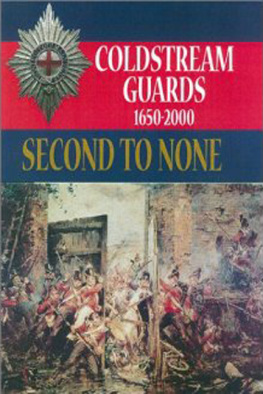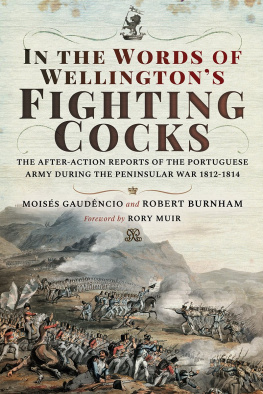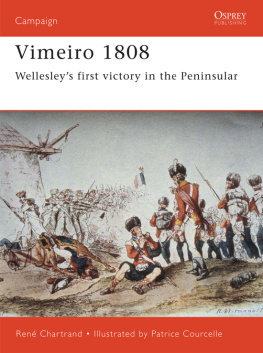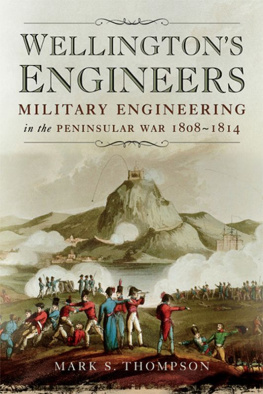WELLINGTONS
PENINSULAR WAR
by the same author
Counter-Insurgency Campaigning
Last Post: Aden, 196467
The Story of the Guards
The Pageantry of Britain
The Yeoman of the Guard
Discovering London Ceremonial and Traditions
Hougoumont
WELLINGTONS
PENINSULAR WAR
Battles and Battlefields
Julian Paget
First published in Great Britain in 1990
and reprinted in 2005 and 2009 in this format by
Pen & Sword Military
An imprint of
Pen & Sword Books Ltd
47 Church Street
Barnsley
South Yorkshire
S70 2AS
Copyright Julian Paget, 1990, 2005, 2009
ISBN 978 1 84415 290 2
The right of Julian Paget to be identified as Author of this work has been asserted
by him in accordance with the Copyright, Designs and Patents Act 1988.
A CIP catalogue record for this book is
available from the British Library
All rights reserved. No part of this book may be reproduced or transmitted in any
form or by any means, electronic or mechanical including photocopying, recording or by
any information storage and retrieval system, without permission from the Publisher
in writing.
Printed and bound in England
By CPI UK
Pen & Sword Books Ltd incorporates the Imprints of Pen & Sword Aviation,
Pen & Sword Maritime, Pen & Sword Military, Wharncliffe Local history,
Pen & Sword Select, Pen & Sword Military Classics and Leo Cooper.
For a complete list of Pen & Sword titles please contact
PEN & SWORD BOOKS LIMITED
47 Church Street, Barnsley, South Yorkshire, S70 2AS, England
E-mail: enquiries@pen-and-sword.co.uk
Website: www.pen-and-sword.co.uk
Contents
List of Maps
by The Duke of Wellington, LVO, OBE, MC, DL
Many years ago when I was Defence Attach at the British Embassy in Madrid I had the opportunity to visit and walk over most of the battlefields of the Peninsular war. It is something I would thoroughly recommend to all who are interested in military history; but ones appreciation of a field of battle of the past is enormously heightened if reference can be made to an account of the battle which not only details the sequence of events but gives an up-to-date picture of what one is looking for. Over the centuries features change and modern developments radically alter the topography. Today the ridge of Busaco for instance is covered by trees and Vitoria and Talavera are bisected by motorways. I was lucky enough on my walks over those historic fields to have in my hand Jac Wellers recently published Wellington in the Peninsula which enabled me to re-create vividly in my mind those scenes of long ago.
The pace of change in Spain and Portugal has increased rapidly in the last twenty-five years and an up-to-date picture of those great campaigns in the Peninsular is long overdue. In Julian Pagets book we have that picture, greatly enhanced by the authors own distinguished career in the Army. He approaches the problems faced by my ancestor with the sort of military perception which will benefit his readers when they visit the battlefields and of which I hope to take advantage in the years ahead.
Acknowledgements
I am very grateful to a number of people for the help they have given me over this book. I owe much in the first place to Serena Fass and the staff of Serenissima Travel for setting me on the path of studying the battlefields of the Peninsular War. I am also indebted to Stephen Drake-Jones, Chairman of the Wellington Society of Spain for checking many facts, figures and references for me; Michael Stilwell and Robert Bremner for help over the campaigning in Portugal; Lord Nicholas Gordon-Lennox, British Ambassador in Madrid, and his staff for their help and support; Lt-Colonel Bill Watson for supplying some of the maps and Neil Hyslop for drawing them so effectively; also Mrs Gibbon for typing the manuscript. I am also most grateful to Colonel Henry Radice who provided many of the photographs of the battlefields which appear in the book.
There have been many books written about the Peninsular War, and I hesitate to add yet another to the list. But, having led several battlefield tours to the Peninsula, it seems to me that there is a need for one, simple account of the campaign.
Some of the histories are classics, but out of date. Some cover particular aspects, such as Michael Glovers excellent Wellingtons Army. Some are very involved; some are biased one way or another. The only one that deals with the actual battlefields is Jac Wellers Wellington in the Peninsula, but that was written 20 years ago and is now out of print.
My aim in this book is to provide a short, simple but complete account of the whole war, including details of the battlefields as they are today, and how to go and look at them. This account is written primarily from a British viewpoint, but I have tried to present a balanced picture of the whole campaign, giving due credit to the Spanish and Portuguese war efforts, without which victory would not have been possible.
The book is written in various sections, giving varying degrees of detail. It starts with a broad-brush review of the whole war and the background to it, for those who want to grasp the outline story and the historical setting in just one chapter. Then there is an account of the war year by year, outlining events in more detail: these seven chapters give a complete and chronological account of the whole campaign.
Finally, there is a chapter on each of the major battles in which the Peninsular Army was involved. These include a detailed account of the battle, maps of the battlefields, orders of battle, and instructions on how to find the battlefield today and what to see there. The maps show the ground as it was at the time of the Peninsular War, but also include enough modern features such as roads, railways and landmarks, to enable readers to identify the ground where the fighting took place.
In addition, there are several Appendices giving basic information about the rival armies, the commanders involved and the British regiments which saw service in the war.
It is hoped that this approach will be of interest to a wide range of people, including the general reader, the professional historian, the harassed young officer seeking a quick answer and tourists who want to look at history and stand where Wellington stood.
There is something very dramatic and impressive, to my mind, about standing today where Wellington stood, and being able to look at the same ground as he did. Most of the battlefields of the Peninsular War are still identifiable, and are not built over, though there are unfortunately motorways across both Talavera and Vitoria.
In most cases, it is not difficult to envisage the battle, and I hope my book may help readers to do just that. Salamanca, Talavera and Vitoria can be clearly imagined. The Crossing of the Douro took place near the modern road bridge (and temptingly near the port lodges of Vila Nova!). The Lines of Torres Vedras can be seen on many hilltops. One can still stand on Cadouxs Bridge across the Bidassoa or on the Tres Puentes Bridge at Vitoria. There is a modern motorway along much of the Retreat to Corunna, but it is still possible to follow the old road, and one can easily still imagine the horrors and hardships of that mid-winter nightmare.
Studying the Peninsular War, I have been constantly struck by the number of comparisons that can be made with the Second World War, and it is one of the themes of the book. To give just two examples: the importance to British strategy of sea-power is dominant throughout both wars, and on a smaller scale, the parallels between Corunna in 1809 and Dunkirk in 1940 are obvious.
Next page








